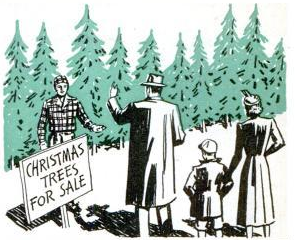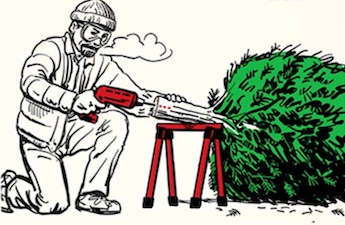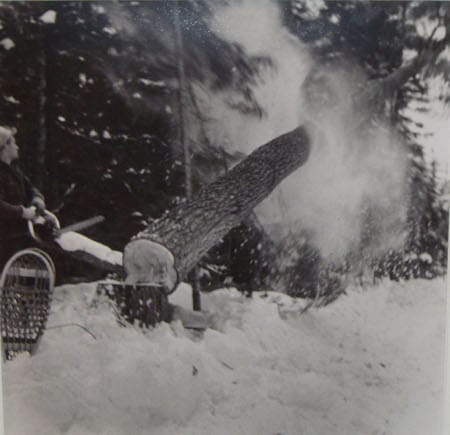
If a man’s job on Thanksgiving is to carve the turkey, his main Christmas responsibility is the selecting and setting up of the tree. The undisputed symbol of the holiday season, the Christmas tree is the centerpiece of one’s holiday decorations, the focus to which the eye is drawn and people gather. A handsome, large, well-decorated tree, with its twinkling lights and festive ornaments, can warm the heart of even the Scroogiest man. No one can resist its allure; even my Jewish friends put up a “Hanukkah” bush.
Selecting, setting up, and caring for your tree is therefore a responsibility you should take seriously. By following these tips, your Christmas tree will be a source of pride for you, and a source of delight for your family and friends.
Selecting a Christmas Tree
1. Never, ever, buy a plastic tree. This is the cardinal rule of Christmas trees. It’s non-negotiable. A lot of myths get floated around about real Christmas trees that simply aren’t true. Yes, artificial trees are convenient. Yes, artificial trees are cheap. But artificial trees are artificial. At a time of year when you’re celebrating the most authentic things in life — joy, family, giving, and faith — a fake, plastic tree is an entirely inappropriate symbol. It’s interesting to note that the creator of the first fake Christmas tree was the Addis Brush Co., maker of green toilet bowl brushes.
You don’t want a gigantic toilet bowl brush in your living room; you want real branches made out of real wood with real green needles on each bough. Most of all, you want the scent of Christmas, the scent of pine to fill your home. Attempting to recreate this scent with an evergreen scented Glade candle is Christmas sacrilege, punishable by 50 lashes.
Need one more reason? While I know not everyone cares about this, for those who do, remember that buying real trees gives jobs to American Christmas tree farmers and others. Buying plastic trees merely spreads some holiday cheer to a factory in China.
2. Buy early. There are a couple of reasons for this. First, you want to have the best selection of trees possible; if you go late, all the trees will have been picked over, and you’ll end up with a Peanuts tree. Secondly, if you’re buying a precut tree, those trees are going to be sitting on the lot every day until Christmas. They’re basking in the sun, not being watered, and drying out. If you buy the tree early, you don’t need to set it up immediately (see “Setting up the Tree” below), but the tree might as well be sitting outside your house in a bucket of water instead of flapping around like a parched goldfish on the lot.
3. Measure the ceiling height where you want to put the tree. You don’t want to pay more for a bigger tree only to have to clip off the top.
4. Visit your local Christmas tree dealer. Your best choice is to head to a Christmas tree farm, where you can cut down a tree right then and there. This not only ensures that you get the freshest tree possible, cutting down a tree will make you feel manly. Plus, the setting helps you get in the holiday mindset. If there isn’t a Christmas tree farm near you, find a tree lot that just sells Christmas trees. Under no circumstances should you buy your Christmas tree in the parking lot of Home Depot. Buying a Christmas tree is a crucial step in getting into the holiday spirit; having a big box store as the backdrop simply won’t do.
5. Select which type of tree you want:
Fraser Fir: The most popular choice for a Christmas tree, the Fraser fir has a nice dark green color, a uniform shape, and that strong, long-lasting Christmas scent you’re looking for. The needles are short and firm, and the tree holds onto them well. The branches are quite sturdy and can support that big clay bagel wreath ornament you made in second grade.
Balsam Fir: Quite similar to the Fraser fir, the Balsam fir has a pleasing shape, long-lasting needles and scent, and a healthy green color.
Douglas Fir: It’s hard to go wrong with a Douglas fir. It has that ideal Christmas tree profile-long and pyramidal-and is uniformly shaped on all sides. The branches hold onto the soft, green or blue-green needles well. Gives off a sweet, citrusy scent.
Leyland Cypress: Popular in the Southeast, the Leyland Cypress comes with a few downsides. The soft, delicate foliage may look pretty, but the branches can’t support heavy ornaments, and the tree has little scent.
Scotch Pine: While we often call every Christmas tree a “pine tree,” most are firs, not pines. But the Scotch pine is the real McCoy. It has a long-lasting pine scent and sturdy branches to hold your heavy ornaments. The tree also resists drying, and even if it does become dry, it won’t drop its needles. On the con side, some people do not like its long, 2-3 inch needles.
Virginia Pine: Typically small to medium in size, the Virginia pine has sturdy branches and a scent Pine-sol will never be able to duplicate. The needles of the Virginia pine grow in pairs that become twisted with each other, resulting in dense foliage. The branches hold onto the needles well.
6. Look for shape, then size. Of course, the thrill of the search is to find a tree that is both nicely shaped and magnificently large. But while is tempting to simply go for the gargantuan tree, the first thing to look for is pleasing proportionality. A nicely shaped tree will get more compliments than a mammoth but gangly one. Look for large gaps or holes in the branches. Don’t buy a tree from a lot where they keep the trees locked down under netting. You won’t be able to tell what the tree really looks like. And the tree is longing to break its shackles and breathe free. But you may want to ask for the tree to be netted before you go home; it makes carrying the tree much easier.
When it comes to size, keep in mind the number of ornaments and strings of lights you have to decorate the tree with. A gargantuan tree with only a sprinkling of ornaments will look silly; likewise, a small tree struggling to support six ornaments per branch with appear garish.
7. Check for freshness. Ask the seller when the trees were cut. Look for nice, green needles, and check for the presence of brown ones. But remember, many sellers paint their trees to increase the green color. Check the branches and bark for green coloring. While some do this simply to enhance the tree’s greenness, others may be hiding a wilted, brown tree. Run your hand down the branch; most of the needles should stay put. Bend the needles. On a fir tree, the needle should snap crisply; on a pine tree, the needle should bend and not break.
Setting up Your Christmas Tree
1. Wait until about two weeks before Christmas to bring the tree inside the house for decorating. You’re surely eager to get the tree up and decked out, but leaving the tree outside will keep it fresh longer. The more time the tree spends sitting inside your warm, centrally heated home, the faster it’s going to dry out and drop its needles. Keep the tree sitting in a bucket of water while it’s outside.
2. Choose a location away from heat sources. When you do bring the tree inside, set it up away from heating vents, radiators, and other hot spots. They will dry the tree out quicker than Bunnicula sucking on a carrot.
3. Saw off an inch from the bottom of the tree. The bottom of the tree gets sappy, and this prevents water from being absorbed into the wood. Some tree places will do this sawing for you when you buy the tree.
4. Cut off any branches that interfere with placing the tree in the tree stand.
5. Make it straight. When you place the tree in the tree stand, make sure it’s standing as straight and tall as a Marine at attention. While this can be a painstaking task, if the tree is crooked, it’s going to bother you every day until Christmas. So keep making adjustments until it’s just right.
Caring for Your Christmas Tree
Keep it watered. Trees drink water like camels, so be sure to check the level of water in the tree stand every day and make sure the bottom of the tree is immersed.
Check out our comprehensive guide on how to keep a Christmas tree fresh, longer.
Also, don’t forget our guide on how to put lights on a Christmas tree without swearing up a storm.







